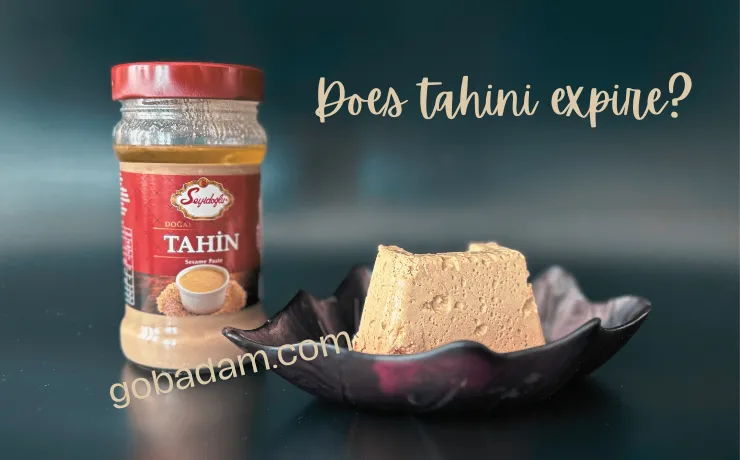Can Tahini go bad? Ah, tahini! This velvety sesame treasure has been gracing our plates and palates for centuries. With its increasing popularity in kitchens worldwide, understanding its quirks and nuances has never been more essential. But, a pressing question arises for all gourmet enthusiasts: Can tahini go bad? Let’s journey through the world of tahini, discovering its intricacies together!
Can Tahini go bad?
Yes, tahini can go bad if not stored properly or kept for an extended period beyond its expiration date. However, factors such as delaying spoilage and reducing negative changes in taste are also up to you. Factors such as your usage and storage areas and conditions may affect its staleness or spoilage positively or negatively.
If you suspect that your tahini is spoiled or has expired, just in case stop using it. Get a fresh tahini and enjoy..
Let’s take a closer look at this unique taste made from sesame oil. In this guide, we will unveil the secrets of tahini and learn how to preserve its freshness.

What is Tahini?
Tahini is a simple yet luxurious paste made primarily from toasted ground sesame seeds. Its origins trace back to ancient Middle Eastern, North African, and Mediterranean cultures.
The Preservation of Nutrients and Flavor
Tahini isn’t just a flavor powerhouse; it’s packed with nutritional benefits from calcium to antioxidants. Storing it away from direct sunlight helps preserve these nutrients. Thus, every spoonful you consume is not only delicious but remains loaded with all its health benefits.
Composition Matters
Comprising mostly of oils and proteins, tahini is rich in essential nutrients. The sesame seeds contribute not only to its unique flavor but also pack it with vitamins, minerals, and antioxidants.

Shelf Life of Tahini: The Longevity of Sesame’s Finest
While many gourmet products have fleeting freshness, tahini’s robust nature gives it quite a lifespan. Unopened, it boasts a shelf life that can stretch anywhere from 6 months to a year. Once you break that seal and let the air in, though, you’re looking at a window of about 4-6 months. This is assuming you haven’t introduced contaminants and stored it appropriately.
So, what makes tahini stay fresh for so long? It boils down to its minimal water content and high oil content, which naturally acts as a preservative. However, this doesn’t mean it’s immune to going off. As with all food products, its interaction with its environment plays a critical role in its shelf life.
The Art of Storing Tahini
Choosing the right home for your tahini makes all the difference. Think of tahini as a fine wine; it needs that cool, dark place to mature gracefully. Tahini thrives in inconsistent temperatures. Rapid changes can affect its constitution, leading to separation or changes in consistency.
While refrigeration is optional, it can prolong its life, especially in hotter climates. A tight seal ensures it remains uncontaminated, retaining its pure, rich flavor.
However, if you do opt for the fridge, remember that tahini will thicken. This doesn’t affect its quality but might require a bit of stirring before use to achieve that desired creamy consistency. Also, it can affect the taste by the way.
Another important point is light. UV rays and direct sunlight can degrade its nutrients. Hence, a cool, dark place like a pantry or a refrigerator ensures its longevity.
Airtight Containers for Freshness
Consistency is the name of the game when it comes to tahini storage. Rapid temperature changes can cause it to lose its smooth texture, leading to undesirable granularity. An airtight container is paramount to protect it from external flavors and maintain its creamy state. Consider investing in quality containers if you’re a frequent tahini user, ensuring that each scoop is as delightful as the last.
SEE OFFER 👉🏻 airtight lid glass jar
The Subtle Signs of Spoiled Tahini
Even the finest of delicacies can fall victim to the ravages of time. With tahini, signs of spoilage can be subtle, demanding a keen eye and nose. So you don’t have to taste it to know if it’s spoiled or not.

Smelling Tahini
Fresh tahini has a nutty and pleasant aroma. Any sour or rancid smell indicates that it’s past its prime. Rancid smells are the most obvious red flags – a shift from its naturally nutty aroma to something sour or off-putting.
Sometimes our nose may not be able to smell, and sometimes we may not be sure. Then, taking a look at the visual clues can be a sign to understand whether the tahini has gone bad or not.
Visual Cues for Spoiled Tahini
Watch out for mold, discoloration, or an excessively dry, crumbly texture. These are clear indicators of spoilage.
Visually, if it appears too dry, discolored, or presents any mold – it’s time for it to go. While it’s tough parting with a beloved jar, your health and culinary experience should always be paramount.
Tahini, in its undisturbed state, can display a layer of oil atop. Before you jump to conclusions, this is a natural occurrence and not an indication of spoilage. In fact, this oil layer can act as a protective barrier, sealing in freshness. Give it a gentle mix, and it will effortlessly return to its creamy, blended state.
The Unseen Dangers of Rancid Tahini
While we’ve touched on the sensory signs of spoiled tahini, it’s essential to understand the implications of consuming it. Rancidity in oils can lead to the production of free radicals, potentially harmful compounds that might contribute to chronic diseases. Ingesting spoiled tahini, apart from the unpleasant taste, might lead to digestive discomfort.
Free Radicals and Their Impact
Rancid tahini can lead to the ingestion of free radicals, which are associated with various health concerns. Ensuring your tahini is fresh not only ensures a delightful flavor but also keeps health risks at bay.
Be careful not to exceed the expiration date on the packaging.
While it shares the stage with various other nut and seed butter, tahini stands out, not only in flavor but also in its storage needs. Its unique consistency and oil content demand a bit more attention and care. However, with the insights shared above, ensuring its longevity is a walk in the park!
Last but not least! Tahini isn’t just a food item; it’s a culinary heritage passed down through generations, refined and perfected over time. With the right care, it can continue to be the star in your kitchen, bringing joy to your dishes and warmth to your heart. Dive into the world of tahini, experiment, enjoy, and always remember – a little care goes a long way in preserving this sesame delight!

Frequently Asked Questions About Can Tahini Go Bad?
I hope it was worth the time you spent on this journey where we did our best to keep the tahini from spoiling. Here are the top questions about whether can tahini go bad and how to store it properly.
Is Tahini vegan and gluten free?
Yes, tahini is a paste made primarily from toasted sesame seeds, which means it is naturally vegan, containing no animal products or by-products. Additionally, sesame seeds do not contain gluten, making tahini gluten-free.
However, if you have severe gluten sensitivities or celiac disease, it’s crucial to ensure that the tahini you purchase hasn’t been cross-contaminated with gluten during processing or packaging. Always check labels or reach out to manufacturers if you’re uncertain about a product’s gluten-free status.
Does preparation of tahini influence its shelf life?
Yes, the method of tahini preparation can influence its shelf life. Traditional stone-ground tahini, cherished for its authentic flavor, might have a slightly shorter shelf life than its more commercially processed counterparts due to minimal processing. This isn’t necessarily a drawback – it’s a testament to its purity. But it does mean you should be extra attentive to its storage conditions and any signs of aging.
How to maximize the flavor of tahini?
To maximize flavor, it’s vital to ensure your tahini remains uncontaminated. Introducing foreign substances, even something as simple as crumbs from a piece of bread can alter its taste profile. Using clean, dry utensils will ensure that your tahini retains its characteristic nutty richness without any unsavory interruptions.
You can learn more about foods: do capers go bad, does pasta go bad, how long does cornstarch last, Does honeycomb go bad, do Wasa crackers go bad, does Halloween candy expire, and how long do bagels last?


